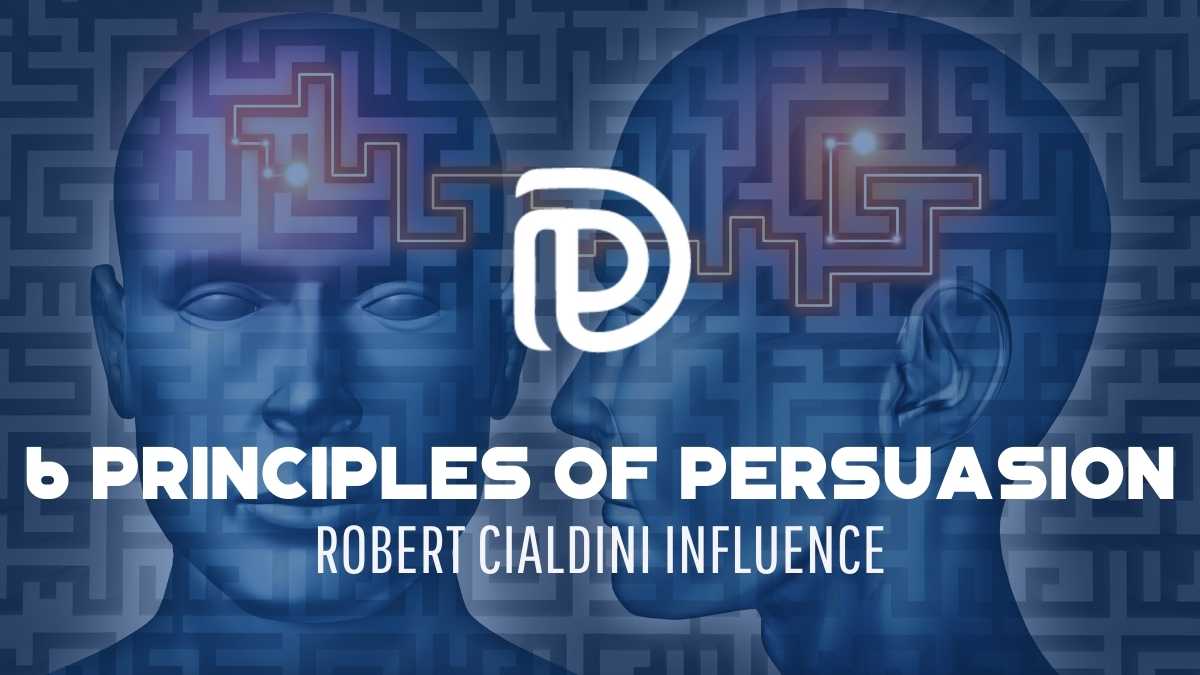6 Principles of Persuasion – Robert Cialdini Influence
One of the most important things we can do as parents is teach our kids the necessary skills to get them ready to enter the real world. I wish someone would have forced me to learn the three main ones I think are critical no matter what field you choose:
- Marketing
- Sales
- Customer Service
One of the things my kids are going to do (if they want mom & dad to use their 529 college fund to pay for school) is attend the Disney College Program.
It’s a semester-long paid internship in which students:
- work in a front-line role at Disney’s theme parks and resorts
- participate in college-level coursework
- live in company-sponsored housing with other students
The education that they’ll receive in Disney customer service, marketing and sales is nothing like they could get from anywhere else at that age.
Another key to success is learning the principle of persuasion or how to get someone to say “yes” to do what we feel is in their best interest. This is especially crucial in sales (even if you’re selling them on a particular treatment that they need performed).
One of the best sources for this information is a must-read book that can be found on The Resource Page:
Dr. Robert Cialdini Influence: The Psychology of Persuasion
Who Is Dr. Robert Cialdini?
According to Wikipedia, Dr. Robert Cialdini is the Regents’ Professor Emeritus of Psychology and Marketing at Arizona State University.
He is best known for his books Influence and Pre-suasion (mentioned above) originally written in 1984. It’s based on three years he spent “undercover” applying for and training at:
- used car dealerships
- fund-raising organizations
- telemarketing firms
He did this to observe real-life situations on how to improve on the science of persuasion. This is like what the “mystery shoppers” do today.
He found that influence is based on six key principles:
- Reciprocity
- Commitment and Consistency
- Social Proof
- Authority
- Liking
- Scarcity
Doctors Influence Patients
As a doctor or student, you probably haven’t spent much time perfecting your persuasive speaking skills. After all, you’re a doctor, not a salesman. Your job is to provide knowledge and treatment to move people towards their best interests & not convince them to buy something they don’t need.
Now, to some extent, you’d be right by thinking this, but I want to clarify some things for so we’re all on the same page.
Convincing someone to say “Yes” to something they don’t need is called Coercion or Intimidation. When we talk about when we influence and persuade people to say “yes” to treatment recommendations, we’re talking about something completely different.
Your main job is getting them healthy and not sales.
After applying these principles to your practice, you’ll understand that there’s an ethical way to set the stage for more patients to follow your treatment recommendations.
You’ll not only be giving them the best possible service but also making it a win-win scenario for you both which will build a lasting relationship.
The Dr. Robert Cialdini Influence book contains six chapters on the various ways that we are susceptible to influence and persuasion (in both harmful and helpful ways).
Let’s break each one down and discuss Cialdini’s point of view of each…
Cialdini’s 6 Principles of Influence & Persuasion
1) Reciprocity
We’re deeply wired to be reciprocal. It’s for this reason that people are more likely to say “Yes” to your request when you first give them a small, unexpected, meaningful gift. Basically, “If you’ll scratch my back, I’ll scratch yours.”
This could also be termed the “quid pro quo principle” for all of you “The Silence of The Lambs” fans.
In the movie, when Hannibal Lecter is being interrogated by FBI Agent Clarice Starling, he says, “Quid pro quo …Clarice ..”. This latin expression could be translated as “something for something”, implying that in exchange for his information, he expected other information from Clarice. He expected a reciprocal treatment.
Have you ever bought someone’s lunch? What do they usually say afterwards? Is it something like, “You don’t have to do that, let me buy yours next time.”
That’s the principle of Reciprocity in action.
Simply put, people are obliged to give back to others the form of a behavior, gift, or service that they have received first.
So, for instance, at an event where dentists are trying to attract new patients, you might hand out gift bags with a toothbrush, tube of toothpaste, and some floss. Sure this initial gift might be expected.
However, before someone walks away, if you ask, “Would you like an extra toothbrush for someone else in your family?” Suddenly, you’ve given that person an unexpected gift targeted to their needs. They’re more likely to book an appointment, because now they feel a sense of obligation to reciprocate.
2) Scarcity
It’s a hard-wired part of human nature. When there’s less of something, we want it more. People tend to have a harder time dealing with the thought of losing something over the prospect of gaining something. This concept is also known as “loss aversion.”
We assume that things that are difficult to obtain are usually better than those that are easily available. We link availability to quality.

We use this influence at work daily in our practice. In order to motivate patients to schedule for their surgery, we tell them that we only have X number of spots available that month. We’re being up front and honest with them but saying it in a way to motivate them to not put it off.
By doing this, they are much more likely to schedule before leaving the office the day of their consultation.
Bottom line, people want more of those things they can have less of.
3) Authority
Science tells us is that it’s important to signal to others what makes you a credible, knowledgeable authority before you make your influence attempt.
The vast majority of the human population is made up of followers and are looking for someone to lead them. If you have a well-defined niche, then it is possible to become the authority in that niche.
Have you ever heard that content is king? It’s true, and we’ve seen it first hand in our practice.
When I first started practicing, I realized I was answering the same questions from patients over and over again.
So, I decided to do something about it and created a pamphlet which over time turned into a book:
The Consumer’s Guide To Safe, Anxiety Free Dental Surgery
Little did I know that this would be one of the major factors patients sought us out due to being seen as an authority.
If you’re looking for help with something (ex: personal finance) and read a book about it, more than likely the author will be seen an authority in your eyes. Most people don’t have the time researching and look for an authority to help them short cut the process.
Remember, if you want to use this principle, realize that your expertise isn’t always a known quantity, so be sure to convey it when you get the chance.
4) Commitment & Consistency
In the Dr. Robert Cialdini Influence book, it claims that this principle has to do with someone’s self-image. It describes the way in which people want their beliefs and behaviors to be consistent with their values and self-image.
Most know that being a “man of your word” is an attractive social trait to possess. It’s for this reason that we want to be seen as consistent in what we say we’re going to do.
People like to be consistent with the things they have previously said or done. Consistency is activated by looking for, and asking for, small initial commitments that can be made.
There’s a great example in the book that highlights a famous set of studies where researchers found rather that only a small number of people would be willing to erect a large, ugly wooden sign in their front yard to support a Drive Safely campaign in their neighborhood.
However in a similar neighborhood, only a few streets over, there were four times as many homeowners that indicated they’d be willing to put it in their yard.
Why?
Because only ten days earlier, they had agreed (committed) to place a small postcard in their front window that showed their support for the campaign.
Little did the researchers know that small card was the initial commitment that led to a 400% increase in a much bigger but still consistent change.
We use this principle daily which helps to reduce the number of people who don’t show up for their appointment. We do this by having their patients fill out their own appointment cards. Small commitment? Yes. But because they wrote it down themselves, they are now more likely to show up for that future appointment.
5) Liking
People are more likely to follow your advice if they like you.
This explains why we trust word-of-mouth recommendations from friends.
Our practice recently ran into some major computer issues. I contacted a friend who was knowledgeable with computers and immediately called the person he recommended due to the trust I have with him.
When you’re dealing with patients/clients/customers, make it a point to build rapport and find common ground with small talk. If you can connect with them on their hobbies or interests, you’ll have a solid ground to build from.
6) Social Proof
“Since 95 percent of the people are imitators and only 5 percent initiators, people are persuaded more by the actions of others than by any proof we can offer.” – Dr. Robert Cialdini Influence book
People will do things that they see others doing. This is why in advertisements, certain social networks show you which of your friends like a page, or are going to an event. This is also known as, “Monkey see, monkey do.”
A perfect example of Social Proof can be seen whenever someone is shopping online. If I’m searching to buy something on Amazon, such as a pair of hunting boots, I’m more likely to buy the ones that have the best reviews.
In our practice, when patients are undecided about whether or not they should have their procedure performed with IV sedation, we use social proof.
We say, “Mrs. Jones, most of our patients tell us that being sedated under these circumstances was the best thing that they have done in a long time.”
My staff knows that by using ethical persuasion, we can help patients overcome their fears and accept the treatment that they need.
What are some of the ways you use Cialdini’s principles in your daily life?
Don’t Miss Any Updates. Each week I’ll send you advice on how to reach financial independence with passive income from real estate.
Sign up for my newsletter



